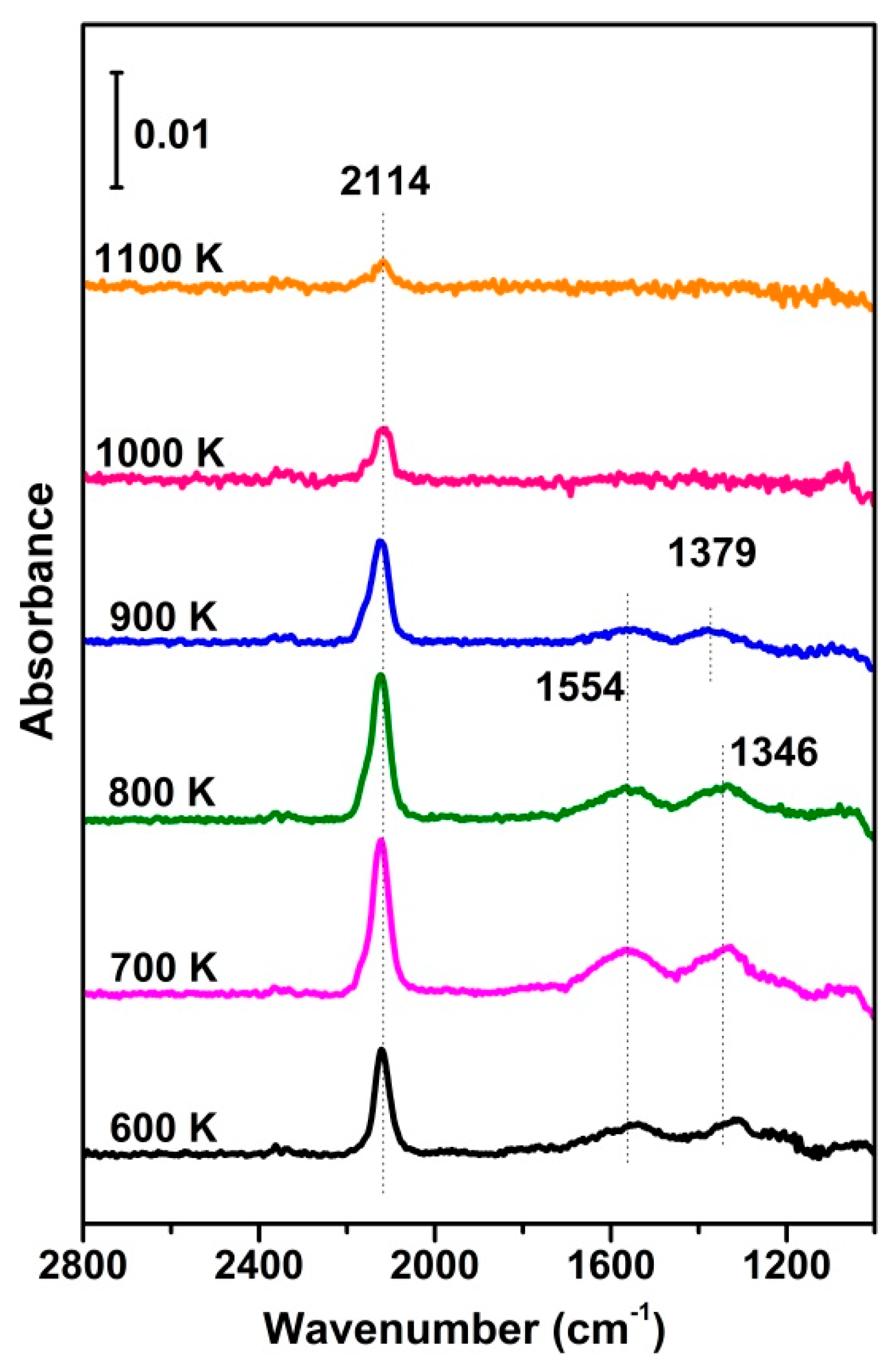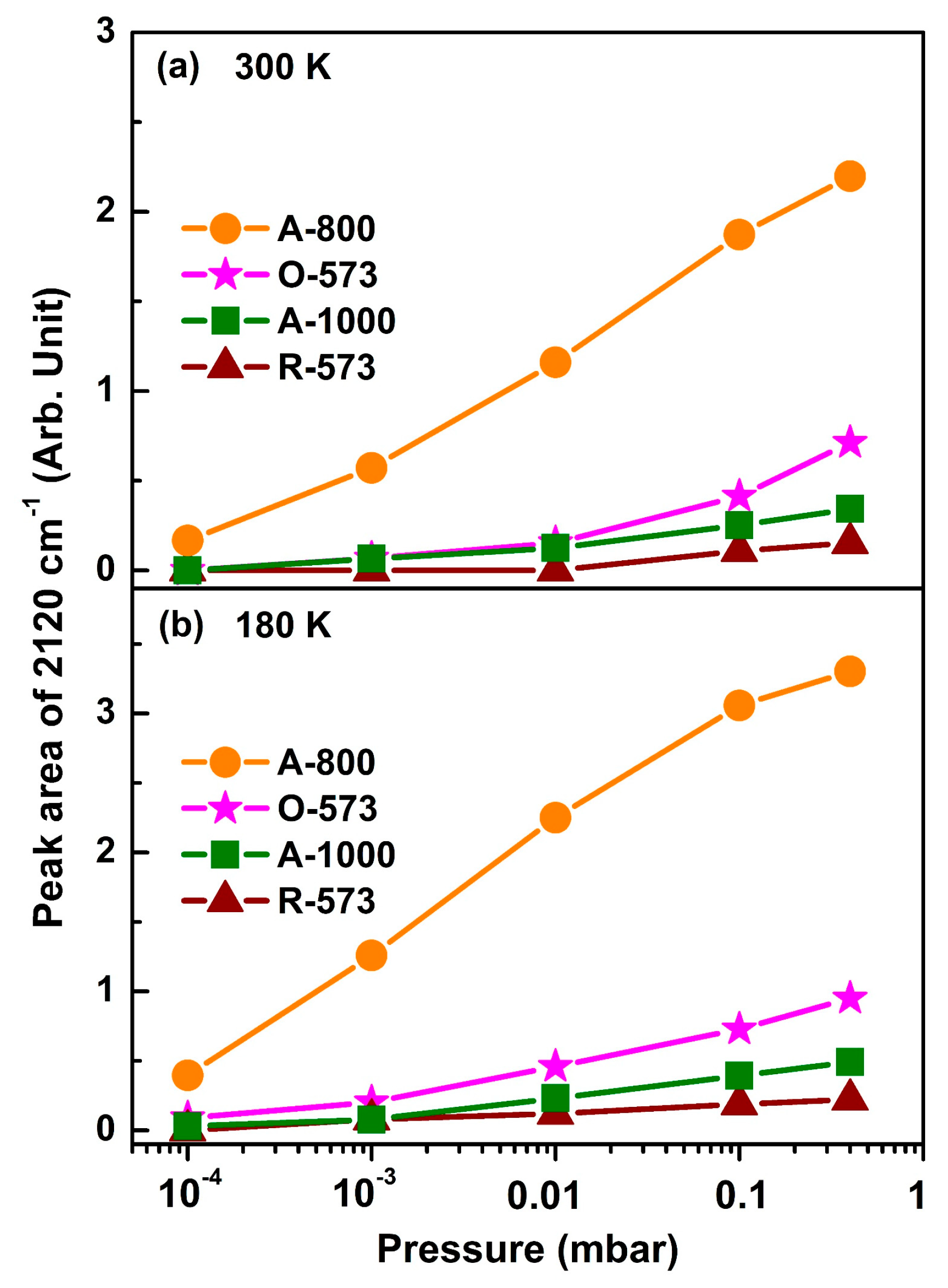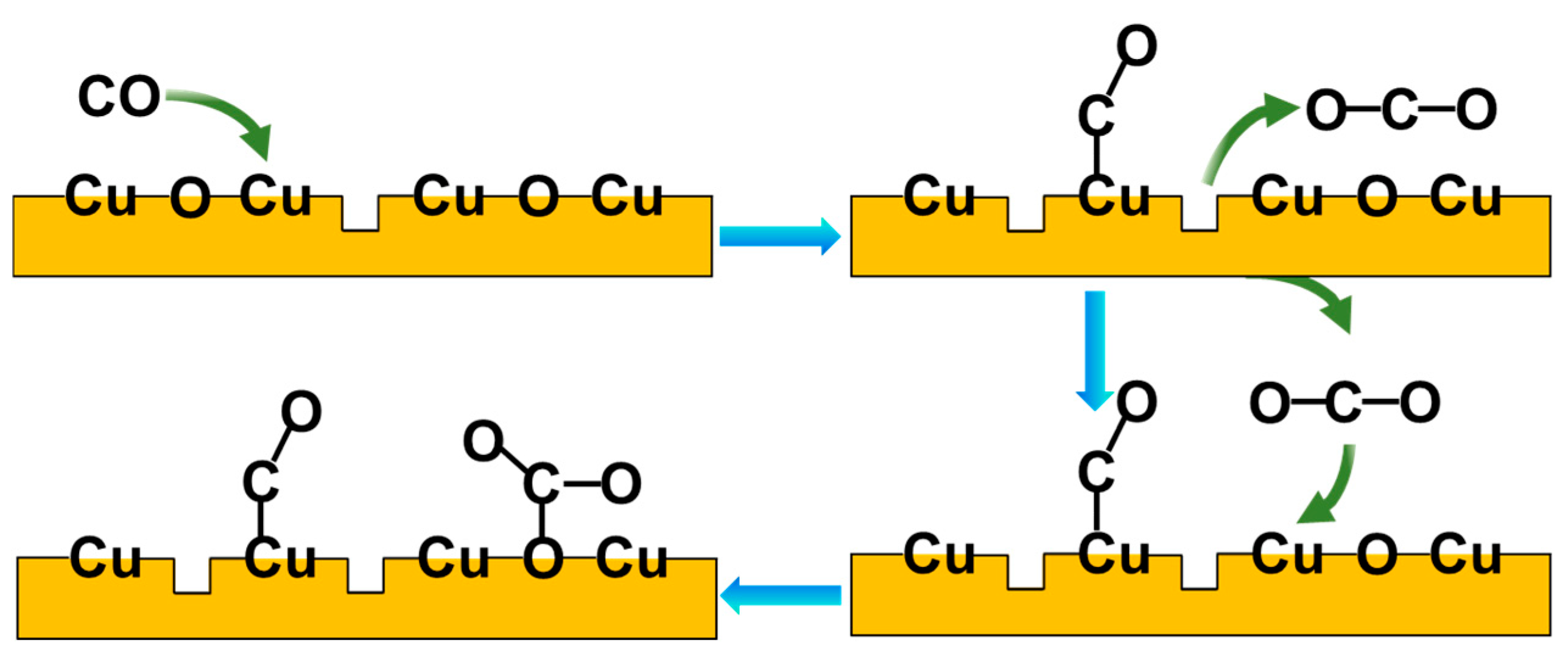Direct Spectroscopic Comparison of CO Adsorption over CuOx Prepared In Situ
Abstract
:1. Introduction
2. Results and Discussion
3. Materials and Methods
3.1. Sample Preparation
3.2. Characterization Methods
4. Conclusions
Supplementary Materials
Author Contributions
Funding
Data Availability Statement
Acknowledgments
Conflicts of Interest
References
- Swallow, J.E.N.; Jones, E.S.; Head, A.R.; Gibson, J.S.; David, R.B.; Fraser, M.W.; van Spronsen, M.A.; Xu, S.; Held, G.; Eren, B.; et al. Revealing the role of CO during CO2 hydrogenation on Cu surfaces with in situ soft X-ray spectroscopy. J. Am. Chem. Soc. 2023, 145, 6730–6740. [Google Scholar] [CrossRef]
- Yang, M.; Yu, J.; Zimina, A.; Sarma, B.B.; Pandit, L.; Grunwaldt, J.D.; Zhang, L.; Xu, H.; Sun, J. Probing the nature of zinc in copper-zinc-zirconium catalysts by operando spectroscopies for CO2 hydrogenation to methanol. Angew. Chem.-Int. Ed. 2023, 62, e202216803. [Google Scholar] [CrossRef] [PubMed]
- Kuld, S.; Thorhauge, M.; Falsig, H.; Elkjær, C.F.; Helveg, S.; Chorkendorff, I.; Sehested, J. Quantifying the promotion of Cu catalysts by ZnO for methanol synthesis. Science 2016, 352, 969–975. [Google Scholar] [CrossRef] [PubMed]
- Sun, J.; Liu, F.; Salahuddin, U.; Wu, M.; Zhu, C.; Lu, X.; Zhang, B.; Zhao, B.; Xie, Z.; Ding, Y.; et al. Optimization and understanding of ZnO nanoarray supported Cu-ZnO-Al2O3 catalyst for enhanced CO2-methanol conversion at low temperature and pressure. Chem. Eng. J. 2023, 455, 140559–140569. [Google Scholar] [CrossRef]
- Zhang, Z.; Cheng, S.; Liu, W.; Chen, B.; Gao, X.; Wang, P.; Gao, J.; Tan, Y.; Dang, S.; Tu, W. Unraveling the regulation of Mn in Cu-ZnOx formation during methanol synthesis from syngas over Cu/ZnO/Al2O3-Mn catalysts. Appl. Catal. B-Environ. 2023, 338, 122985–122998. [Google Scholar] [CrossRef]
- Bahmani, M.; Farahani, B.V.; Sahebdelfar, S. Preparation of high performance nano-sized Cu/ZnO/Al2O3 methanol synthesis catalyst via aluminum hydrous oxide sol. Appl. Catal. A-Gen. 2016, 520, 178–187. [Google Scholar] [CrossRef]
- Wang, J.; Song, Y.; Li, J.; Liu, F.; Wang, J.; Lv, J.; Wang, S.; Li, M.; Bao, X.; Ma, X. Modulation of Al2O3 and ZrO2 composite in Cu/ZnO-based catalysts with enhanced performance for CO2 hydrogenation to methanol. Appl. Catal. A-Gen. 2024, 674, 119618–119627. [Google Scholar] [CrossRef]
- Zhang, Z.; Chen, X.; Kang, J.; Yu, Z.; Tian, J.; Gong, Z.; Jia, A.; You, R.; Qian, K.; He, S.; et al. The active sites of Cu-ZnO catalysts for water gas shift and CO hydrogenation reactions. Nat. Commun. 2021, 12, 4331–4339. [Google Scholar] [CrossRef]
- Phey, M.L.P.; Abdullah, T.A.T.; Ali, U.F.M.; Mohamud, M.Y.; Ikram, M.; Nabgan, W. Reverse water gas shift reaction over a Cu/ZnO catalyst supported on regenerated spent bleaching earth (RSBE) in a slurry reactor: The effect of the Cu/Zn ratio on the catalytic activity. RSC Adv. 2023, 13, 3039–3055. [Google Scholar] [CrossRef]
- Stone, F.S.; Waller, D. Cu-ZnO and Cu-ZnO/Al2O3 catalysts for the reverse water-gas shift reaction. The effect of the Cu/Zn ratio on precursor characteristics and on the activity of the derived catalysts. Top. Catal. 2003, 22, 305–318. [Google Scholar] [CrossRef]
- Galván, C.Á.; Schumann, J.; Behrens, M.; Fierro, J.L.G.; Schlögl, R.; Frei, E. Reverse water-gas shift reaction at the Cu/ZnO interface: Influence of the Cu/Zn ratio on structure-activity correlations. Appl. Catal. B-Environ. 2016, 195, 104–111. [Google Scholar] [CrossRef]
- Liu, X.; Piscina, P.R.d.l.; Toyir, J.; Homs, N. CO2 reduction over Cu-ZnGaMO (M = Al, Zr) catalysts prepared by a sol-gel method: Unique performance for the RWGS reaction. Catal. Today 2017, 296, 181–186. [Google Scholar] [CrossRef]
- Shi, Y.; Xu, L.; Chen, M.; Yang, B.; Cheng, G.; Wu, C.; Miao, Z.; Wang, N.; Hu, X. Fabricating Cu2O-CuO submicron-cubes for efficient catalytic CO oxidation: The significant effect of heterojunction interface. J. Ind. Eng. Chem. 2022, 105, 324–336. [Google Scholar] [CrossRef]
- Meng, M.; Liu, Y.; Sun, Z.; Zhang, L.; Wang, X. Synthesis of highly-dispersed CuO-CeO2 catalyst through a chemisorption-hydrolysis route for CO preferential oxidation in H2-rich stream. Int. J. Hydrogen Energy 2012, 37, 14133–14142. [Google Scholar] [CrossRef]
- Cruz, A.R.M.; Assaf, E.M.; Gomes, J.F.; Assaf, J.M. Active copper species of co-precipitated copper-ceria catalysts in the CO-PROX reaction: An in situ XANES and DRIFTS study. Catal. Today 2021, 381, 42–49. [Google Scholar] [CrossRef]
- Wang, Q.; Gong, J.; Zhang, H.; Fan, Q.; Xue, L.; Wu, J.; Li, J.; Wang, Y.; Liu, Z.; Gao, R.; et al. Co-promotion of two-type active sites: PtCu single-atom alloy and copper-ceria interface for preferential oxidation of CO. Appl. Catal. B-Environ. 2022, 306, 121117–121128. [Google Scholar] [CrossRef]
- Chagas, C.A.; Schmal, M. The effect of copper oxide on the CuO-NiO/CeO2 structure and its influence on the CO-PROX reaction. Int. J. Hydrogen Energy 2022, 47, 8858–8866. [Google Scholar] [CrossRef]
- Avgouropoulos, G.; Ioannides, T. Selective CO oxidation over CuO-CeO2 catalysts prepared via the urea-nitrate combustion method. Appl. Catal. A-Gen. 2003, 244, 155–167. [Google Scholar] [CrossRef]
- Wan, H.; Li, D.; Dai, Y.; Hu, Y.; Zhang, Y.; Liu, L.; Zhao, B.; Liu, B.; Sun, K.; Dong, L.; et al. Effect of CO pretreatment on the performance of CuO/CeO2/γ-Al2O3 catalysts in CO+O2 reactions. Appl. Catal. A-Gen. 2009, 360, 26–32. [Google Scholar] [CrossRef]
- Zhong, J.; Yang, X.; Wu, Z.; Liang, B.; Huang, Y.; Zhang, T. State of the art and perspectives in heterogeneous catalysis of CO2 hydrogenation to methanol. Chem. Soc. Rev. 2020, 49, 1385–1413. [Google Scholar] [CrossRef]
- Natesakhawat, S.; Lekse, J.W.; Baltrus, J.P.; Ohodnicki, P.R., Jr.; Howard, B.H.; Deng, X.; Matranga, C. Active sites and structure-activity relationships of copper-based catalysts for carbon dioxide hydrogenation to methanol. ACS Catal. 2012, 2, 1667–1676. [Google Scholar] [CrossRef]
- Hu, J.; Li, Y.; Zhen, Y.; Chen, M.; Wan, H. In situ FTIR and ex situ XPS/HS-LEIS study of supported Cu/Al2O3 and Cu/ZnO catalysts for CO2 hydrogenation. Chin. J. Catal. 2021, 42, 367–375. [Google Scholar] [CrossRef]
- Laudenschleger, D.; Ruland, H.; Muhler, M. Identifying the nature of the active sites in methanol synthesis over Cu/ZnO/Al2O3 catalysts. Nat. Commun. 2020, 11, 3898–3907. [Google Scholar] [CrossRef] [PubMed]
- Szanyi, J.; Goodman, D.W. Methanol synthesis on a Cu(100) catalyst. Catal. Lett. 1991, 10, 383–390. [Google Scholar] [CrossRef]
- Kattel, S.; Ramírez, P.; Chen, J.; Rodriguez, J.; Liu, P. Active sites for CO2 hydrogenation tomethanol on CuZnO catalysts. Science 2017, 355, 1296–1299. [Google Scholar] [CrossRef] [PubMed]
- Chinchen, G.; Spencer, M.; Waught, K.; Whan, D. Promotion of methanol synthesis and the water-gas shift reactions by adsorbed oxygen on supported copper catalysts. J. Chem. Soc. Faraday Trans. 1987, 83, 2193–2212. [Google Scholar] [CrossRef]
- Schott, V.; Oberhofer, H.; Birkner, A.; Xu, M.; Wang, Y.; Muhler, M.; Reuter, K.; Wöll, C. Chemical activity of thin oxide layers: Strong interactions with the support yield a new thin-film phase of ZnO. Angew. Chem.-Int. Ed. 2013, 52, 11925–11929. [Google Scholar] [CrossRef]
- Wang, Z.; Xu, Z.; Peng, S.; Zhang, M.; Lu, G.; Chen, Q.; Chen, Y.; Guo, G. High-performance and long-lived Cu/SiO2 nanocatalyst for CO2 hydrogenation. ACS Catal. 2015, 5, 4255–4259. [Google Scholar] [CrossRef]
- Kamsuwan, T.; Krutpijit, C.; Praserthdam, S.; Phatanasri, S.; Jongsomjit, B.; Praserthdam, P. Comparative study on the effect of different copper loading on catalytic behaviors and activity of Cu/ZnO/Al2O3 catalysts toward CO and CO2 hydrogenation. Heliyon 2021, 7, e07682–e07691. [Google Scholar] [CrossRef]
- Jung, K.T.; Bell, A.T. Effects of zirconia phase on the synthesis of methanol over zirconia-supported copper. Catal. Lett. 2002, 80, 63–68. [Google Scholar] [CrossRef]
- Rhodes, M.D.; Pokrovski, K.A.; Bell, A.T. The effects of zirconia morphology on methanol synthesis from CO and H2 over Cu/ZrO2 catalysts Part II. Transient-response infrared studies. J. Catal. 2005, 233, 210–220. [Google Scholar] [CrossRef]
- Rhodes, M.D.; Bell, A.T. The effects of zirconia morphology on methanol synthesis from CO and H2 over Cu/ZrO2 catalysts Part I. Steady-state studies. J. Catal. 2005, 233, 198–209. [Google Scholar] [CrossRef]
- Liu, Y.; Liu, J.; Liu, S.; Li, J.; Gao, Z.; Zuo, Z.; Huang, W. Reaction mechanisms of methanol synthesis from CO/CO2 hydrogenation on Cu2O(111): Comparison with Cu(111). J. CO2 Util. 2017, 20, 59–65. [Google Scholar] [CrossRef]
- Amorim, R.; Batista, K.; Nagurniak, G.; Orenha, R.; Parreira, R.; Piotrowski, M. CO, NO, and SO adsorption on Ni nanoclusters: A DFT investigation. Dalton Trans. 2020, 49, 6407–6417. [Google Scholar] [CrossRef]
- Nagarajan, V.; Chandiramouli, R. A DFT study on adsorption behaviour of CO on Co3O4 nanostructures. Appl. Surf. Sci. 2016, 385, 113–121. [Google Scholar] [CrossRef]
- Rochana, P.; Wilcox, J. A theoretical study of CO adsorption on FeCo(100) and the effect of alloying. Surf. Sci. 2011, 605, 681–688. [Google Scholar] [CrossRef]
- Hammer, B.; Morikawa, Y.; Nørskov, J. CO chemisorption at metal surfaces and overlayers. Phys. Rev. Lett. 1996, 76, 2141–2144. [Google Scholar] [CrossRef]
- Hammer, B.; Nørskov, J. Theoretical surface science and catalysis-calculations and concepts. Adv. Catal. 2000, 45, 71–129. [Google Scholar]
- Ai, X.; Xie, H.; Chen, S.; Zhang, G.; Xu, B.; Zhou, G. Highly dispersed mesoporous Cu/γ-Al2O3 catalyst for RWGS reaction. Int. J. Hydrogen Energy 2022, 47, 14884–14895. [Google Scholar] [CrossRef]
- Miao, C.; Zhou, G.; Chen, S.; Xie, H.; Zhang, X. Synergistic effects between Cu and Ni species in NiCu/γ-Al2O3 catalysts for hydrodeoxygenation of methyl laurate. Renew. Energy 2020, 153, 1439–1454. [Google Scholar] [CrossRef]
- Noei, H.; Qiu, H.; Wang, Y.; Muhler, M.; Wöll, C. Hydrogen loading of oxide powder particles: A transmission IR study for the case of zinc oxide. ChemPhysChem 2010, 11, 3604–3607. [Google Scholar] [CrossRef] [PubMed]
- Wang, X.; Lu, B.; Li, L.; Qiu, H. Exploring the interactions of oxygen with defective ZnO. ChemistryOpen 2018, 7, 491–494. [Google Scholar] [CrossRef] [PubMed]
- Wan, H.; Wang, Z.; Zhu, J.; Li, X.; Liu, B.; Gao, F.; Dong, L.; Chen, Y. Influence of CO pretreatment on the activities of CuO/γ-Al2O3 catalysts in CO+O2 reaction. Appl. Catal. B-Environ. 2008, 79, 254–261. [Google Scholar] [CrossRef]
- Xie, Z.; Hei, J.; Cheng, L.; Li, J.; Yin, X.; Meng, S. Influence of Cu/Al ratio on the performance of carbon-supported Cu/ZnO/Al2O3 catalysts for CO2 hydrogenation to methanol. Catalysts 2023, 13, 800. [Google Scholar] [CrossRef]
- Jiang, L.; Zhu, H.; Razzaq, R.; Zhu, M.; Li, C.; Li, Z. Effect of zirconium addition on the structure and properties of CuO/CeO2 catalysts for high-temperature water-gas shift in an IGCC system. Int. J. Hydrogen Energy 2012, 37, 15914–15924. [Google Scholar] [CrossRef]
- Wang, L.; Peng, H.; Shi, S.; Hu, Z.; Zhang, B.; Ding, S.; Wang, S.; Chen, C. Metal-organic framework derived hollow CuO/CeO2 nano-sphere: To expose more highly dispersed Cu-O-Ce interface for enhancing preferential CO oxidation. Appl. Surf. Sci. 2022, 573, 151611–151622. [Google Scholar] [CrossRef]
- Ding, J.; Geng, Z.; Li, L.; Wang, Y.; Zuo, Y.; Li, H.; Yang, M.; Li, G. Migration of cations in layered oxides for creating a highly active interface toward CO preferential oxidation. J. Mater. Chem. A 2021, 9, 12623–12635. [Google Scholar] [CrossRef]
- Kydd, R.; Ferri, D.; Hug, P.; Scott, J.; Teoh, W.Y.; Amal, R. Temperature-induced evolution of reaction sites and mechanisms during preferential oxidation of CO. J. Catal. 2011, 277, 64–71. [Google Scholar] [CrossRef]
- Sharma, S.K.; Paul, B.; Pal, R.S.; Bhanja, P.; Banerjee, A.; Samanta, C.; Bal, R. Influence of Indium as a promoter on the stability and selectivity of the nanocrystalline Cu/CeO2 catalyst for CO2 hydrogenation to methanol. ACS Appl. Mater. Interfaces 2021, 13, 28201–28213. [Google Scholar] [CrossRef]
- Manzoli, M.; Monte, R.D.; Boccuzzi, F.; Coluccia, S.; Kaspar, J. CO oxidation over CuOx-CeO2-ZrO2 catalysts: Transient behaviour and role of copper clusters in contact with ceria. Appl. Catal. B-Environ. 2005, 61, 192–205. [Google Scholar] [CrossRef]
- Li, F.; Zhao, B.; Tan, Y.; Chen, W.; Tian, M. Preparation of Al2O3-CeO2 by hydrothermal method supporting copper oxide for the catalytic oxidation of CO and C3H8. Ind. Eng. Chem. Res. 2022, 61, 4739–4751. [Google Scholar] [CrossRef]
- Wang, W.; Qu, Z.; Song, L.; Fu, Q. CO2 hydrogenation to methanol over Cu/CeO2 and Cu/ZrO2 catalysts: Tuning methanol selectivity via metal-support interaction. J. Energy Chem. 2020, 40, 22–30. [Google Scholar] [CrossRef]
- Pokrovski, K.; Jung, K.T.; Bell, A.T. Investigation of CO and CO2 adsorption on tetragonal and monoclinic zirconia. Langmuir 2001, 17, 4297–4303. [Google Scholar] [CrossRef]
- Bando, K.; Sayama, K.; Kusama, H.; Okabe, K.; Arakawa, H. In-situ FT-IR study on CO2 hydrogenation over Cu catalysts supported on SiO2, Al2O3, and TiO2. Appl. Catal. A-Gen. 1997, 165, 391–409. [Google Scholar] [CrossRef]
- Baber, A.; Xu, F.; Dvorak, F.; Mudiyanselage, K.; Soldemo, M.; Weissenrieder, J.; Senanayake, S.; Sadowski, J.; Rodriguez, J.; Matolín, V.; et al. In situ imaging of Cu2O under reducing conditions: Formation of metallic fronts by mass transfer. J. Am. Chem. Soc. 2013, 135, 16781–16784. [Google Scholar] [CrossRef]
- Dandekar, A.; Vannice, M. Determination of the dispersion and surface oxidation states of supported Cu catalysts. J. Catal. 1998, 178, 621–639. [Google Scholar] [CrossRef]
- Wang, Y.; Kováčik, R.; Meyer, B.; Kotsis, K.; Stodt, D.; Staemmler, V.; Qiu, H.; Traeger, F.; Langenberg, D.; Muhler, M.; et al. CO2 activation by ZnO through the formation of an unusual tridentate surface carbonate. Angew. Chem.-Int. Ed. 2007, 46, 5624–5627. [Google Scholar] [CrossRef]
- Zhang, G.; Fan, G.; Zheng, L.; Li, F. Ga-promoted CuCo-based catalysts for efficient CO2 hydrogenation to ethanol: The key synergistic role of Cu-CoGaOx interfacial sites. ACS Appl. Mater. Interfaces 2022, 14, 35569–35580. [Google Scholar] [CrossRef]
- Ren, Z.; Peng, F.; Li, J.; Liang, X.; Chen, B. Morphology-dependent properties of Cu/CeO2 catalysts for the water-gas shift reaction. Catalysts 2017, 7, 48. [Google Scholar] [CrossRef]
- Zhang, X.; Li, G.; Tian, R.; Feng, W.; Wen, L. Monolithic porous CuO/CeO2 nanorod composites prepared by dealloying for CO catalytic oxidation. J. Alloy. Compd. 2020, 826, 154149. [Google Scholar] [CrossRef]
- Mendes, P.; Ocampo-Restrepo, V.; Silva, J. Ab initioinvestigation of quantum size effects on the adsorption of CO2, CO, H2O, and H2 on transition-metal particles. Phys. Chem. Chem. Phys. 2020, 22, 8998–9008. [Google Scholar] [CrossRef] [PubMed]
- Du, Y.; Li, L.; Wang, X.; Qiu, H. A newly designed infrared reflection absorption spectroscopy system for in situ characterization from ultrahigh vacuum to ambient pressure. Appl. Spectrosc. 2017, 72, 122–128. [Google Scholar] [CrossRef] [PubMed]






| O-573 | R-573 | A-800 | A-1000 | |
|---|---|---|---|---|
| Peak TPR area (a.u.) | 33,558 | - | 25,207 | 16,909 |
| BET surface area (m2/g) | 68.20 | 65.14 | 65.40 | 54.5 |
| Grain size (nm) * | 13.06 | 24.15 | 17.28 | 20.58 |
Disclaimer/Publisher’s Note: The statements, opinions and data contained in all publications are solely those of the individual author(s) and contributor(s) and not of MDPI and/or the editor(s). MDPI and/or the editor(s) disclaim responsibility for any injury to people or property resulting from any ideas, methods, instructions or products referred to in the content. |
© 2024 by the authors. Licensee MDPI, Basel, Switzerland. This article is an open access article distributed under the terms and conditions of the Creative Commons Attribution (CC BY) license (https://creativecommons.org/licenses/by/4.0/).
Share and Cite
Zhang, Y.; Liu, Y.; Zhao, R.; Lu, B.; Wang, X.; Qiu, H. Direct Spectroscopic Comparison of CO Adsorption over CuOx Prepared In Situ. Catalysts 2024, 14, 578. https://doi.org/10.3390/catal14090578
Zhang Y, Liu Y, Zhao R, Lu B, Wang X, Qiu H. Direct Spectroscopic Comparison of CO Adsorption over CuOx Prepared In Situ. Catalysts. 2024; 14(9):578. https://doi.org/10.3390/catal14090578
Chicago/Turabian StyleZhang, Yanmin, Yu Liu, Rui Zhao, Bin Lu, Xuan Wang, and Hengshan Qiu. 2024. "Direct Spectroscopic Comparison of CO Adsorption over CuOx Prepared In Situ" Catalysts 14, no. 9: 578. https://doi.org/10.3390/catal14090578







